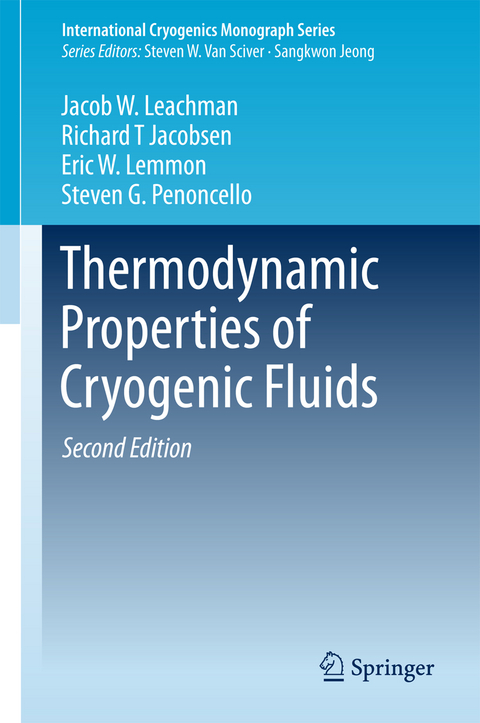
Thermodynamic Properties of Cryogenic Fluids
Springer International Publishing (Verlag)
978-3-319-57833-0 (ISBN)
This update to a classic reference text provides practising engineers and scientists with accurate thermophysical property data for cryogenic fluids. The equations for fifteen important cryogenic fluids are presented in a basic format, accompanied by pressure-enthalpy and temperature-entropy charts and tables of thermodynamic properties.
It begins with a chapter introducing the thermodynamic relations and functional forms for equations of state, and goes on to describe the requirements for thermodynamic property formulations, needed for the complete definition of the thermodynamic properties of a fluid. The core of the book comprises extensive data tables and charts for the most commonly-encountered cryogenic fluids.
This new edition sees significant updates to the data presented for air, argon, carbon monoxide, deuterium, ethane, helium, hydrogen, krypton, nitrogen and xenon. The book supports and complements NIST's REFPROP - an interactive database and toolfor the calculation of thermodynamic properties of cryogenic fluids.
Dr. Richard Jacobsen is Executive Director for Research and Technology Transfer and Professor of Nuclear Engineering at Idaho State University (ISU). Dr. Jacobsen’s research publications include 11 books and chapters in books; 60 refereed journal publications; 11 refereed conference proceedings; and 108 research reports, notes and technical reports. Dr Steven Penoncello is a faculty member in the Department of Mechanical Engineering at U Idaho, and director of the Center for Applied Thermodynamic Studies (CATS). Dr. Eric Lemmon received his Ph.D. at the University of Idaho in 1996. His current work focuses on the Refprop program (www.nist.gov/srd/nist23.cfm) and on national and international standards for the properties of natural gas. Dr. Jacob Leachman is a faculty member of the School of Mechanical and Materials Engineering at Washington State University and heads the HYdrogen Properties for Energy Research (HYPER) laboratory.
Preface Second Edition.- Preface First Edition.- Acknowledgments.- Symbols.- 1 Importance and uses of cryogenic fluid properties.- 2 Equation of State Development and Use.- 3 Helium.- 4 Hydrogen.- 5 Deuterium.- 6 Neon.- 7 Nitrogen.- 8 Air.- 9 Carbon Monoxide.- 10 Fluorine.- 11 Argon.- 12 Oxygen.- 13 Methane.- 14 Krypton.
| Erscheinungsdatum | 22.08.2017 |
|---|---|
| Reihe/Serie | International Cryogenics Monograph Series |
| Zusatzinfo | XVI, 213 p. 6 illus. |
| Verlagsort | Cham |
| Sprache | englisch |
| Maße | 155 x 235 mm |
| Gewicht | 504 g |
| Themenwelt | Naturwissenschaften ► Physik / Astronomie ► Theoretische Physik |
| Naturwissenschaften ► Physik / Astronomie ► Thermodynamik | |
| Schlagworte | Cryogenic Fluid Data • engineering thermodynamics • Engineering Thermodynamics, Heat and Mass Transfer • Equations of State for Cryogenic Fluids • industrial chemistry & chemical engineering • Industrial chemistry & chemical engineering • Industrial Chemistry/Chemical Engineering • low temperature physics • Physics • Physics and Astronomy • Properties of Gases at Low Temperature • Properties of Liquid Air • Properties of Liquid Argon • Properties of Liquid Carbon Monoxide • Properties of Liquid Deuterium • Properties of Liquid Ethane • Properties of Liquid Fluorine • Properties of Liquid Helium • Properties of Liquid Hydrogen • Properties of Liquid Krypton • Properties of Liquid Methane • Properties of Liquid Neon • Properties of Liquid Nitrogen • Properties of Liquid Oxygen • Properties of Liquid Parahydrogen • Properties of Liquid Xenon • Thermodynamic Properties of Cryogenic Fluids • Thermodynamic Property Formulations • thermodynamics • Thermodynamics & heat • Thermodynamics & heat |
| ISBN-10 | 3-319-57833-2 / 3319578332 |
| ISBN-13 | 978-3-319-57833-0 / 9783319578330 |
| Zustand | Neuware |
| Informationen gemäß Produktsicherheitsverordnung (GPSR) | |
| Haben Sie eine Frage zum Produkt? |
aus dem Bereich


